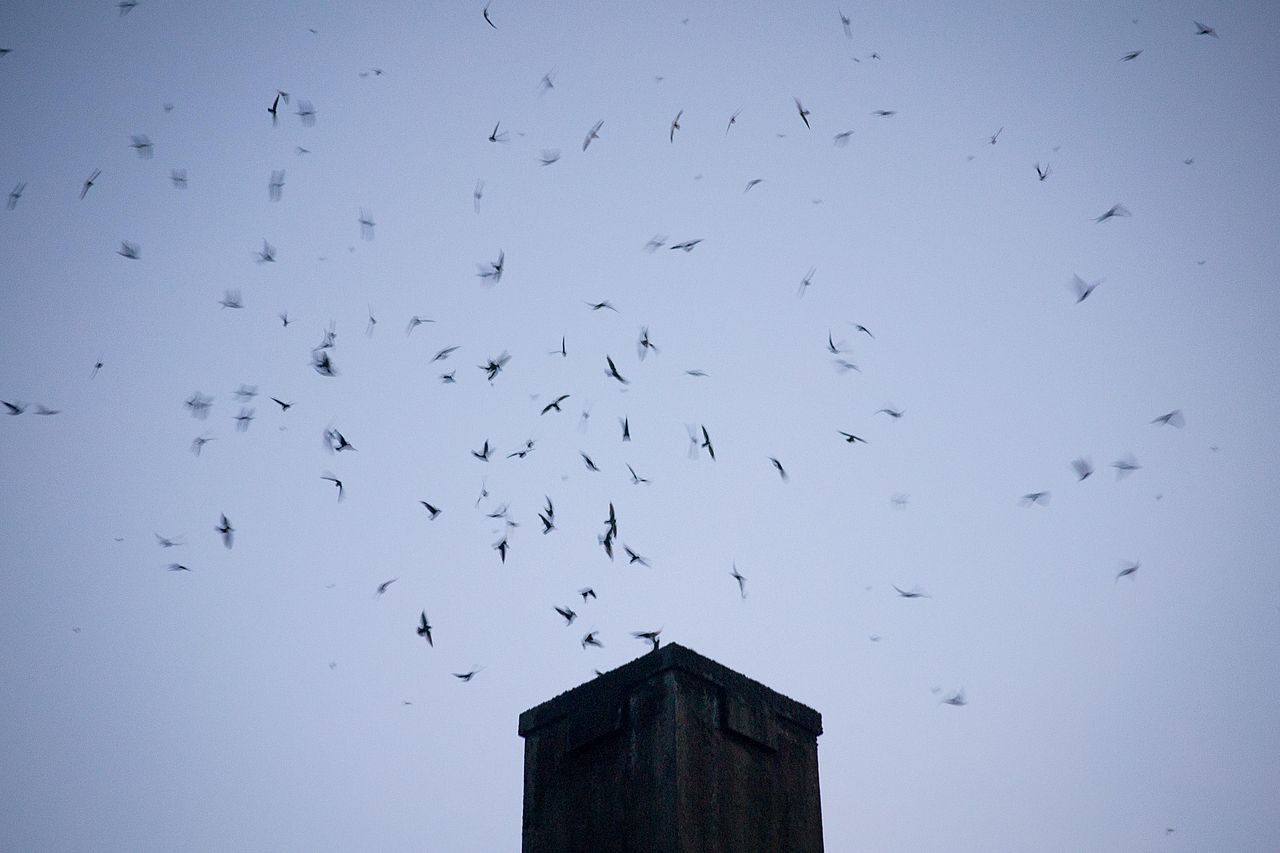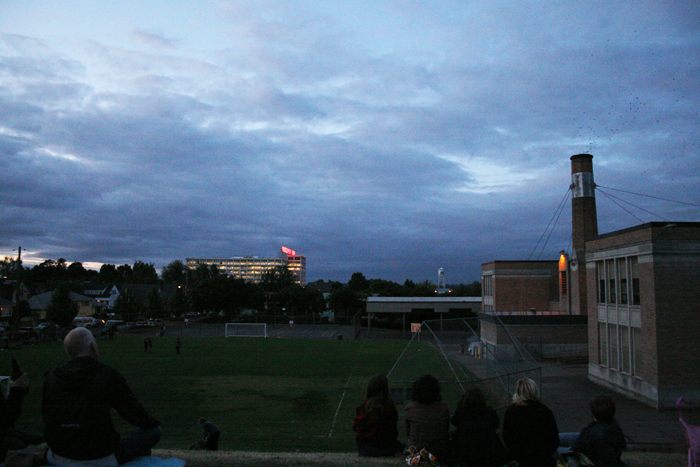How a Chimney in Portland Became a Fall Hostel for Thousands of Tiny Birds

Migrating Vaux’s swifts roost in Agate Hall chimney at the University of Oregon. (Photo: Visitor7/WikiCommons CC BY-SA 3.0)
Eleven months out of the year Chapman Elementary School is a quiet, nondescript brick building in Portland, Oregon. But in September, thousands of people trudge at dusk to the school’s astroturf soccer field to sit and stare at a roof. Specifically these people are looking at Chapman’s chimney. The show begins when a single bird flaps toward the building. One turns into a few. A few turn into many. Soon enough, thousands of small birds are swirling around this one chimney, almost mimicking smoke, slowly hovering. Then, like a vortex of avians, the birds descend en masse into a large brick steam vent.
These birds are known as Vaux’s swifts. They are about five inches long, with short stiff beaks and grayish-brown coats. Many have compared the swifts’ body shape to a cigar, and when you see thousands of them in the sky, they do tend to resemble a flock of winged cylinders.
When the swifts descend on Chapman it’s just one part of their yearly migration. During the spring and summer the birds live predominantly in the Pacific Northwest, anywhere from Northern California to British Columbia. They find their mates during early spring, lay eggs in July, and then prepare for their long journey south come August.

Watching the arrival of Vaux’s swifts. (Photo: Alice Carrier/flickr)
Like grandparents, swifts prefer to winter where it’s warm. When the weather gets chilly, the birds travel from the Pacific Northwest to varied parts of Central and South America. What makes swifts different from other migratory birds is how they sleep at night. When the migration begins, they join together into flocks of thousands. Their agenda then includes flying during the day and roosting at night, all together in one space.
Because of the size of their flocks, nests will not do. Instead, swifts look for large enclosed areas that can hold huge numbers of the small birds. Their beds of choice are large cavities in old-growth trees, explained Joe Liebezeit of the Portland Audubon Society. The swifts seek out these big hollowed-out areas while flying, hoping to smash in dozens, if not hundreds, of birds to roost. But thanks to industrialization and logging in the Pacific Northwest, ancient trees are increasingly hard to find. “It’s a lot rarer to find big cavities in old-growth trees,” said Liebezeit.
Luckily for the swifts, the logged trees were used to build big buildings–many of which needed large, hollow openings to funnel smoke. And so the swifts discovered chimneys, which soon became a sanctuary for their nomadic slumbers. They are able to cling to the walls of chimneys thanks to their “velcro-like” feet, explains the Audubon Society. A few thousand swifts generally enter a single chimney in the areas they fly over every night. One year saw as many 16,000, said Liebezeit.

Vaux’s swifts at twilight. (Photo: K. Kendall/flickr)
It’s not just the swifts that come to Portland that enjoy chimneys. The birds’ updated roosting spot at Chapman Elementary school has now become a local attraction. While bird watchers like to go into the wilderness to observe new and fascinating birds, any old joe can revel in the beauty of the swifts as they enter urban chimneys. Because of the sheer quantity of birds that go to Chapman, and how unique a swarming flock of swifts diving into a chimney looks, it’s now a Portland tradition to travel to the elementary school and watch the event unfold.
It began as an organic gathering of onlookers noticing swarms of black dots swirling around the chimney. But as it became known that the swifts had an annual congregation at Chapman, the event became more popular. On a nice September night there can be as many as 200 to 3,000 people sitting on the grass looking toward the chimney. “It’s fun to watch,” said Jeremy Lawrence, a Portland resident since 2008. He’s gone to watch the birds twice, once with friends and once on a date.
In 2009 the Audubon Society decided to make it an official community event. The organization now has help from a nearby city park to facilitate parking (after neighbors began complaining about car congestion), and even enlisted the help of citizen volunteers to help educate passersby and count the number of swifts that enter each night. There’s also a website, dubbed Swift Watch, that explains the event to laypeople.

The flock swirling into the school chimney to roost for the night. (Photo: Kat+Sam/WikiCommons CC BY 2.0)
The actual event of watching the birds is similar to tailgating. A large group of people arrange themselves on the soccer field–many bring food, and some surreptitiously drink alcohol. The area is lined with teenage dates, twenty-something friends, and parents bringing their offspring to witness an urban spectacle. One time, Lawrence recounted, a hawk perched onto the chimney in search of prey. It attacked one unlucky bird as the crowd of onlookers booed and cheered.
For weeks each fall, people flock to the field and its surrounding grassy hills to sit and watch the cigar-shaped birds torpedo themselves into one single chimney. Once the swarms of swifts have all decamped south to other hollows, Chapman returns to its normal life as an elementary school. The birds, meanwhile, continue on to their tropical destination.















Follow us on Twitter to get the latest on the world's hidden wonders.
Like us on Facebook to get the latest on the world's hidden wonders.
Follow us on Twitter Like us on Facebook